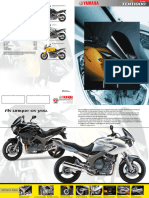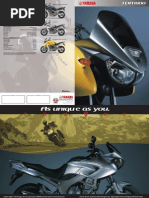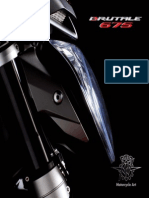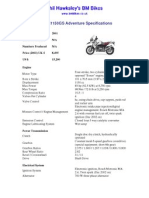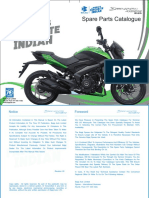1993 Yamaha XTZ 750 Super Ténéré
Uploaded by
thienthanla3m1993 Yamaha XTZ 750 Super Ténéré
Uploaded by
thienthanla3mHome Manufacturer Contact
Yamaha XTZ 750 Super Ténéré
Motoforza fairings and accessories
Racing fairings & accessories
Fairings, rear sets, race seat, subframe and other
parts.
.
Motoforza Open
Make Model Yamaha XTZ 750 Super Ténéré
Year 1993
Four -stroke, parallel twin cylinder, DOHC, 5 valves
Engine
per cylinder
Capacity 749 cc / 45.7 cu-in
Bore x Stroke 87 x 63 mm
Cooling System Liquid cooled,
Compression Ratio 9.5:1
Lubrication Wet sump
Engine Oil 20W/40
Exhaust Single stainless steel pipe
Induction 2x 38mm Mikuni BDST38 CV carburetors
Ignition TCI (Transistor Controlled Ignition)
Spark Plug NGK, DPR8EA-9
Starting Electric
Max Power 69.3 hp / 54 kW @ 7500 rpm
Max Torque 68 Nm / 50.2 lb-fts @ 6750 rpm
Clutch Wet, multiple discs, cable operated
Transmission 5 Speed
Final Drive Chain
Frame Steel, Single cradle frame
Front Suspension Telescopic forks.
Front Wheel Travel 235 mm / 9.2 in
Monoshock, adjustable preload compression
Rear Suspension
damping adjustment
Rear Wheel Travel 215 mm / 8.4 in
Front Brakes 2x 245mm discs
Rear Brakes Single 236mm disc
Front Tyre 90/90-21
Rear Tyre 140/80-17
Length 2285 mm / 90 in
Dimensions
Width 815 mm / 32.1 in
Wheelbase 1505 mm / 59.3 in
Seat Height 865 mm / 34.1 in
Dry Weight 203 kg / 447.5 lbs
Wet Weight 236 kg / 520.3 lbs
Fuel Capacity 26 Litres / 6.6 gal
Consumption Average 16.5 km/lit
Braking 60 - 0 / 100 - 0 14.25 m / 42.06 m
Standing ¼ Mile 12.8 sec / 162.1 km/h
Top Speed 192.0 km/h / 119.3 mph
Road Test Bike Magazine Group Test 1992
Racing fairings &
accessories
.
Fairings, rear sets, race seat,
subframe and other parts.
The developed two-cylinder twin engine has five valves and
downdraft carburettors. The Model set new maximum
performance values in the Enduro scene. It's not as light as a
single cylinder bike and so not to use for everything. But if one
gets used to the weight you can use it quite well off road. The
Super Ténéré is a solid motorcycle for travelling long
distances with much comfort.
Road Test
BANANA REPUBLIC HAS MADE A TIDY SUM SELLING
CLOTHING designed to make the wearer look like a Beirut
combat photographer, to people who've never been any closer
to that war-torn city than the Moroccan restaurant up the
street. And Yamaha is doing much the same thing with its
XTZ750A Super Ténéré. Not that there's any attempt to
deceive on either firm's part. Both are selling an image, one as
romantic and about as tangible—as the scent of a dry desert
wind, and one that can be safely purchased with none of the
risks associated with the real thing. In Yamaha's case, it's the
look of a Paris-Dakar Rally bike, a haute couture item in
Europe for the past decade and a half, and the ultimate
expression of European Mitty motorcyclist fantasies. It's also a
shrewd move, given Yamaha's research that shows a trend
toward high-powered dual-purpose machines among Euro-
consumers. The bike you see here is a Canadian model, lent
to us by Yamaha Motor Canada Ltd. Think of the bike's
appearance in these pages as a trial balloon for the American
market, and as a service to our many Canadian readers.
Whatever you do, though, don't think of the Ténéré as a dirt
bike, because Yamaha doesn't. You might get the wrong idea,
from the Ténéré's glandular, P-D-look fairing and 6.8-gallon
tank, long-travel suspension, and skywalker, 34.3-inch seat
height. But the bike's Brobdingnagian bulk, and 518-pound wet
weight should discourage any such notions. As incongruous
as it might seem, beneath the Ténéré's Bedouin garb lies the
soul of a tourer. But a no-shucks, rough-and-ready dirt bike?
Get real.
Notes from the off-road tester's log: Trying to ride this thing
hard off-road is a mistake. It feels the same as when you've
accidently run off the road on a street bike. Compared to real
dirt bikes, the controls are terrible—stiff clutch-pull; clunky,
long-reach levers; and no front-brake feel. The bike's big,
clumsy and awkWard as it is, and a rider needs all the feel at
his fingertips he can get. On sand, the front end washes out
instantly. Novices shouldn't get anywhere near single-track
stuff; you have to be real damn good to ride on anything other
than fireroads. It can get you places off-road you couldn't get
to on a street bike—but just barely.
We could go on, but you get the picture. Experts leavened
their criticism with praise for the trustworthiness of the front
end and the bike's predictability in slides—under power, on
fireroads, it's better than BMW's B100GS Paris-Dakar, or
Kawasaki's KLR650 or Tengai. The heavier and taller the rider
—with more weight to load the front end, and longer legs to
make a flat-footed dab before the bike gets too far over-center
— the greater the praise. The point, though, is that experts can
compensate for almost anything short of loss of a wheel. Our
5-foot-10, 160-pound dirt donk found himself on the ground
before he could say, "O positive."
Every tester, though, regardless of size, experience, or hat
size enthused about the Ténéré's powerplant. Each time a
rider climbed off the bike, the test log entry started with, "Great
engine," and each discussion of the Yamaha always
mentioned the motor. An all-new design, it's the highest-tech
parallel-twin in motorcycling, with deep thought given to
compact packaging. In the bottom end, the crank and
transmission shafts are staggered, allowing for shorter overall
engine length than if the shafts were in line; the design also
places the crank low in the cases, for a low center of gravity.
Dry-sump lubrication keeps engine height down, and further
lowers the eg. To help quell vibration from the 360-degree-
crank twin, Yamaha tucked in two gear-driven
counterbalancers.
Equally creative thinking guided Yamaha's engineers in
configuring the Ténéré engine's top end. Cam drive is chain off
the crank's end, which yield narrower, more compact cylinder
bk and head than a center cam-drive syste The liquid-cooled
cylinder and head an the mold of Yamaha's Genesis five-va
design, first seen on the firm's groin breaking FZ750 in 1985,
with the sa attendant benefits here. The 45-degr inclined top
end allows nearly straij intake ports for good cylinder-filling fn
the 38mm Mikuni flat-slide downdr carbs; the design also
permits the gas ta to extend into the space over the ca where
the carbs and airbox would be oi vertical twin, again to lower
the i Viewed separately, none of the engin features are unique
or even terribly ori nal; what is, though, is their application one
engine.
Yamaha provided few tuning specifications, but there's ample
evidence for confident speculation. The Ténéré's incredibly
broad powerband and flat torque curve suggest short-duration
camshafts. Plus, the 9.5:1 compression ratio is unusually low
for such an advanced cylinder head design, which suggests
cams with narrow overlap; with less incoming charge lost
through the exhaust valves on overlap, effective compression
ratio is higher than the raw numbers would suggest.
Compared to a two- or four-valve design, the Ténéré's five-
valve setup flows better at low lifts, which, with short-duration,
narrow-overlap cams, boosts low-end and midrange power.
But the five-valve design also provides ample port area for
good flow at high rpm. Essentially, with the Ténéré twin
Yamaha was able to have its cake and eat it too, with power
throughout the rev range. The proof can be found on the dyno,
the strip, the street—and, yes, even in the dirt.
Regardless of the road surface, the Ténéré's twin will charm
your socks clean off, from the moment you punch the starter
button. From cold, the engine lights off instantly, and the choke
can be pushed in almost immediately; throttle response is
crisp and instantaneous. Obviously, the garrote of Canada's
version of the EPA fits more loosely than its Yankee
counterpart's. In character, the engine is as docile and
tractable as a Bedouin's camel on lithium, and it starts making
usable power from rev one. You can lug it around all over town
in fourth or fifth gear without a hint of protest, yet it revs on top,
too, spinning easily past the 8000 rpm redline. On backroads,
the bike achieves its best drives out of turns with the revs kept
near the 7500-rpm power peak, but it doesn't demand such
treatment. The easy-access power makes downshifting more
of an exercise than a requirement. Only abrupt off-idle
response and some driveline lash keep the engine from being
totally hospitable.
The dyno simply reaffirms what riding impressions suggest:
The Ténéré twin is nothing short of a marvel, one of the
strongest twins we've ever lashed to the pump. In fact, in
recent memory, only Ducati's biggest twins, the 851 and 906,
best the Ténéré's 59.8 peak horsepower and 43.7 pound-feet
peak torque. Compared to twins closer to its displacement, the
Ténéré stands head and shoulders higher, with 7 more
horespower at its peak than Suzuki's VX800, 5 more than
Ducati's 750 Sport, and a whopping 19 more than Honda's
XL600V Transalp. Compared to 750 inline-fours, the Ténéré
falls short on peak power, but approaches them in torque; it
even outpowers Honda's torquey VFR750 in the mid-range,
with 6 more horsepower at 6500 rpm. The terrain of the
Ténéré's power and torque curves is wide and flat. In fact, the
torque curve is one of the flattest in motorcycling, never
dropping below 88 percent of its peak from 3500 rpm to
redline.
The Ténéré is no less eye-opening at the drag strip, besting
such pure street-going hardware as the VX800, Ducati 750
Sport and Paso 906, with a 12.5-second quarter-mile sprint.
Taller gearing puts the Yamaha at a disadvantage in roll-ons
against the Sport and VX, and the 906 Paso's superior low-
end and mid-range also help it best the Ténéré in top-gear
comparisons. Although Honda's heavier VFR750F smacks the
Yamaha in the quarter-mile, the two swap the advantage back
and forth in roll-ons.
The Ténéré simply burns down bikes of its own kind: It's
almost a second quicker and 10 mph faster through the
quarter than Honda's lighter Transalp or BMW's mammoth
Paris-Dakar, and substantially quicker in roll-ons. What the
Yamaha does to a single such as Kawasaki's Tengai is too
embarrassing to mention.
Yamaha Super Ténéré XTZ 750 - Meravigliosa Creatura
Chia sẻ
Xem trên
Compared to the engine's glittering technical and performance
credentials, the Ténéré's chassis hardware seems positively
plain. Frame design is utterly conventional, with a single
backbone and double downtubes, constructed of round-and
box-section tubing, with a stamped-steel Deltabox swing arm.
Suspension is by a normal, non-cartridge fork in front, and a
rising-rate system in back with a single shock adjustable for
preload only. Dual-disc brakes in front, a single disc at the
rear, spoke wheels and trials-pattern tires complete the
Ténéré's rolling stock—except for the dual-disc front brake, it's
all pretty standard fare for dual-purpose bikes, of which the
Paris-Dakar genre is an offshoot.
On the road, the Ténéré's chassis performance offers a
mixture of vices and virtues different from those normally
associated with dual-purpose bikes. The first thing a rider has
to deal with is the bike's almost overwhelming size and weight.
It's long, tall, and top-heavy, especially with a full load of fuel.
Of its kind, only BMW's R100GS Paris-Dakar, with its 59.6-
inch wheelbase and 535 pounds, is longer and heavier than
the Yamaha, with a 59.3-inch wheelbase and 518-pound
weight. Extra-long-travel suspension—9.3 inches in front, 8.5
inches at the rear hikes the Ténéré's saddle into the
stratosphere, at 34.3 inches; only Kawasaki's KLR650 is
significantly taller.
Shorter riders can find the Ténéré's weight and bulk
intimidating at first, and even 5-foot-10 riders have to slide a
cheek off the saddle to plant a boot flat on the pavement. But
familiarity, and the upright seating position combined with the
leverage offered by the wide, flat handlebar, breeds
confidence, although not necessarily enough for a rider to
hook the Ténéré like a barrel racer through tight traffic. The
engine's stump-pulling low-end power launches the bike away
from stops with a casual ease, effortlessly putting distance on
other traffic.
Initial suspension travel is stiffer than you'd expect from
something so long-legged, enough so that lighter riders (under
160 pounds) tagged the Ténéré's response as harsh over
small, abrupt bumps. Although overall ride quality falls short of
that provided by BMW's R100GS and Honda's Transalp,
average-weight riders had few complaints, some in fact
eyeballing curbs to run over just to see if they could find a
bump big enough to really upset the suspension.
During spirited backroad romps, the suspension sucks up
bumps with the same easy competence; most paving
imperfections you'll encounter are inconsequential, passing
without notice beneath the Ténéré's legs. Steering is quick and
light, thanks to the bar's ample leverage, but the Yamaha's
weight and size keep it from feeling as agile as a single-
cylinder dual-purpose bike—no surprise there.
The bike takes a confidence-inspiring set in mid-turn, and the
Bridgestone Trail Wing tires offer excellent grip. Despite the
engineers' efforts to make the power-plant narrow and
compact, routing the header pipes together on the right side
pushes the aluminum skid plate and rear brake pedal out far
enough that they drag before the tires lose traction.
On tight, unfamiliar roads, the Ténéré has a couple of quirks
that will keep the rider's hands full if he tries to bump the pace
up to full sport-bike flight. Quick-flick steering is ill-advised,
because the vibration-quelling rubber handlebar mounts tend
to wind up before the front end gets the message, and abrupt
steering inputs can overwhelm front-tire traction. The front
brake offers almost no feedback, and its action isn't
progressive: Dive into a turn too hot, and you get little initial
stopping power. Grab harder, and you get more than you
wanted, making the softly sprung fork nose-dive, which
unloads the rear end and causes a mild oscillation.
Smoothness is the key. The Ténéré works best when you ride
it like a softly sprung shaft-drive machine: Do your braking
early and gently, then guide the bike through the turn under
power to keep it stable on its suspension, and accelerate out.
Using such techniques, you can get a surprising turn of speed
out of the Ténéré, although it's most at home at a less frenetic
pace—as will be the rider.
Which is a fair enough description of sport-touring, an area
where the Yamaha excels with talents that seem wholly out of
keeping with its dirt-going garb. Of course, one could expect
the supple suspension to suck up bumps over choppy
pavement. And given the engine's Sahara-wide powerband,
it's no real surprise the rider can maintain a rapid, no-sweat
pace through open, sweeping turns using only a single gear.
Fourth gives a usable speed range from 40 mph to 105 at red-
line; for tighter roads, third is good for 30 to 86 mph. Engine
smoothness contributes to full use of the broad powerband.
Early in our testing, objectionable vibration seeped up past the
dual counterbal-ancers, and through the handgrips at about
5000 rpm, or 72 mph. But after we'd put 1200 miles on the
bike, the buzzing diminished almost to nothing.
But you'd hardly expect the Ténéré's levels of wind protection
and comfort from a bike whose appearance suggests it would
be most at home wheelieing past the Sphinx. Hands stay
warm behind en-duro-issue plastic hand guards, and the
bulbous fairing shelters the rider from chest to knees, with no
nagging turbulence from behind. There's enough wind roar
coming off the screen to warrant wearing earplugs, though,
and some testers wished for a slightly wider screen to deflect
more air from their arms. But overall, the Yamaha offers the
best weather protection of any of its breed.
Those same qualities help make the Ténéré a good ship of
state—interstate, that is—aided by outstanding range. The
6.8-gallon tank lets the bike wander almost 200 miles before it
goes on reserve, and the seat staves off numb-butt and
saddle-burn long enough to let you use it. Almost every
motorcycle could benefit from such a seat: broad, flat, soft,
and deep.
Sheer size pays dividends for the Ténéré's rider on the open
road, with spacious ergonomics. The pairing of roominess with
the well-shaped and amply padded saddle gives the rider
plenty of options to change position and relieve pressure
points on a long ride, more so than on some pure touring
machines. Add in compliant suspension and decent wind
protection, and the Ténéré makes a relatively tranquil oasis on
You might also like
- Workshop Manual - Ducati Hypermotard 950SP-1-Comprimido100% (1)Workshop Manual - Ducati Hypermotard 950SP-1-Comprimido1,630 pages
- Overhaul Manual C-125 C-145 Series Aircraft Engines: For and 0-30083% (6)Overhaul Manual C-125 C-145 Series Aircraft Engines: For and 0-30065 pages
- REED'S Motor Engineering Knowledge For Marine Engineers PDF100% (5)REED'S Motor Engineering Knowledge For Marine Engineers PDF155 pages
- 2013 2015 Polaris Ranger 800 4X4 Crew 6X6 SM 04670No ratings yet2013 2015 Polaris Ranger 800 4X4 Crew 6X6 SM 04670467 pages
- Signal Analysis - Crank Position Sensor PDF100% (5)Signal Analysis - Crank Position Sensor PDF29 pages
- Engine: VDBMA (Very Dark Blue Metallic A)No ratings yetEngine: VDBMA (Very Dark Blue Metallic A)4 pages
- Jawa 250 TRAVEL Operating Instructions ManualNo ratings yetJawa 250 TRAVEL Operating Instructions Manual23 pages
- Tame The Darkness: Design Features Colour VariantsNo ratings yetTame The Darkness: Design Features Colour Variants2 pages
- 08A009 Two and Three Wheelers Assignment - 1 Royal Enfield100% (1)08A009 Two and Three Wheelers Assignment - 1 Royal Enfield7 pages
- Pure Racing Performance.: All-New 2019 TVS Apache RTR 180 (BS IV)No ratings yetPure Racing Performance.: All-New 2019 TVS Apache RTR 180 (BS IV)2 pages
- Royal Enfield Hunter 350 Technical SpecificationsNo ratings yetRoyal Enfield Hunter 350 Technical Specifications16 pages
- FSAE Design Spec Sheet 2011: Car No. 16 School Chiang Mai UniversityNo ratings yetFSAE Design Spec Sheet 2011: Car No. 16 School Chiang Mai University4 pages
- Triumph Thunderbird, Trophy & Tiger: 650cc & 750cc models: 1950-1983From EverandTriumph Thunderbird, Trophy & Tiger: 650cc & 750cc models: 1950-1983No ratings yet
- Mega Machines: Roar into action with these super-charged racers!From EverandMega Machines: Roar into action with these super-charged racers!No ratings yet
- Road & Track Iconic Cars: CamaroFrom EverandRoad & Track Iconic Cars: CamaroLarry WebsterNo ratings yet
- STAG - TAP - 03 - Manual - ENG - v1.3 2 PDF100% (1)STAG - TAP - 03 - Manual - ENG - v1.3 2 PDF28 pages
- The 1.4L EA211 Gasoline Engine: Self Study Program 820333No ratings yetThe 1.4L EA211 Gasoline Engine: Self Study Program 82033362 pages
- Catalogo de Partes Yamaha Libero 110 PDF PDFNo ratings yetCatalogo de Partes Yamaha Libero 110 PDF PDF2 pages
- Spare Parts Catalogue: Bajaj Auto Limited Akurdi Pune 411 035 IndiaNo ratings yetSpare Parts Catalogue: Bajaj Auto Limited Akurdi Pune 411 035 India79 pages
- Course Komatsu Wb93 97r5 Backhoes Engine Fuel Injection Structure Operation Workshop Data Troubleshooting100% (3)Course Komatsu Wb93 97r5 Backhoes Engine Fuel Injection Structure Operation Workshop Data Troubleshooting24 pages
- Docslide - Us - Corolla Eng Chassis Manual rm821 E1047 PDFNo ratings yetDocslide - Us - Corolla Eng Chassis Manual rm821 E1047 PDF1 page
- TSB Ticking Noise - 2006 Ford Fusion v6-3No ratings yetTSB Ticking Noise - 2006 Ford Fusion v6-35 pages
- Parts Catalogue: RM-Z450K8 RM-Z450K9 RM-Z450L0 RM-Z450L1No ratings yetParts Catalogue: RM-Z450K8 RM-Z450K9 RM-Z450L0 RM-Z450L1132 pages
- Maruti Suzuki S PRESSO Spare Parts Price ListNo ratings yetMaruti Suzuki S PRESSO Spare Parts Price List12 pages















